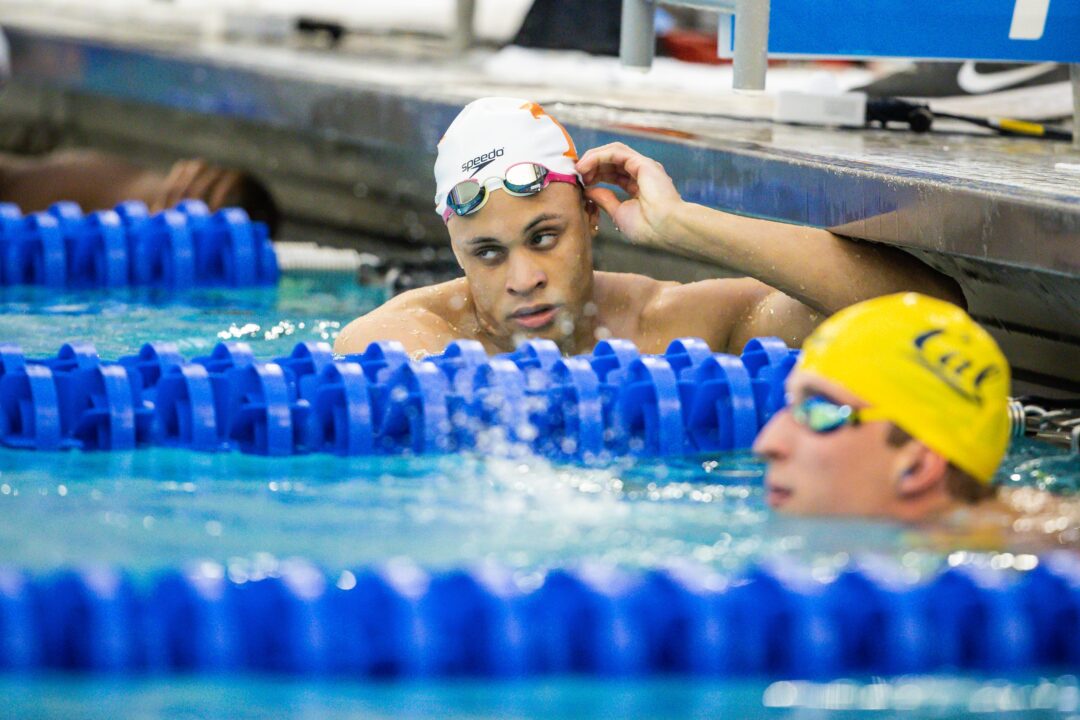Courtesy: Jonah Hendricks
In short, yes, “swimflation” is real. To define the term, “swimflation” is the action of the general increase in fast swimming and increased competition. This is not anything new though. Swimmers have been getting faster since the sport first began. The oldest official world record in the men’s 100 freestyle (LCM) is from a Hungarian named Zoltán Halmay; he went 1:05.8. Now, athletes are going nearly 20 seconds faster than Halmay. So, what is the big deal here? Why is everyone all of a sudden awe-struck by the fast swimming that we’re seeing? To answer that question, the data needs to be analyzed. Are people really improving at a faster rate than before? Are there really more fast age-group swimmers than before, or has the mark just moved to create the illusion of more competition?
Nowadays, it seems that swimming (especially sprinting) has become more competitive than it ever was. Not only are athletes swimming fast times, but a lot of athletes are rapidly approaching records that were once seen to be unbeatable. Over time, there have been many sprinters who have set records in the short-course pool that were seen as untouchable. The likes of Cesar Cielo, Simone Manuel, Caeleb Dressel, and so on have set records that were leagues ahead of their competition at the time. However, now it seems that there are ten times the number of athletes that can achieve these incredible feats. But is there really anything special about this new wave of “swimflation?”
When looking at the number of collegiate swimmers that have gone sub-41.00 in the 100-yard freestyle, the numbers start to reveal part of the picture. Before 2021, there were six athletes who did it. Over the next two years, there were seven athletes who achieved this feat. This demonstrates the recent breakthrough at the top level of collegiate sprinting.
In the past few years, the NCAA has held some of the most top-heavy competitive championships in history. Entering the 2023 100-free A final, there were six athletes that had best times under the 41.00 second marker. Before that year, there had never been an A final with more than one athlete entered under 41.
Looking back to the first time that an athlete went under 41, it was Cesar Cielo in 2008. With a time of 40.92, his record stood for five years. Yet, it wasn’t until 2017 that we saw two athletes do it in the same year. That happened again in 2022. Then, in 2023, there were five athletes to do it. Over the course of just five years, the doors protecting the top level of sprinting broke open.
This improvement is also happening in the relays. The men’s 200-yard freestyle relay saw two teams break an NCAA record that had stood since 2009. Further demonstrating the presence of “swimflation” in NCAA swimming right now.
Moving beyond the collegiate level, age group swimmers have also found ways to sprint faster than before. The first 18U swimmer to break the illustrious 43-second barrier was David Nolan in 2011. Then it wasn’t until the 2015–16 season that we saw multiple swimmers do it in the same year. Last year, there were 8 age-group athletes under 43.00. On the women’s side, the number of age-group athletes under 49.00 in the 100-yard freestyle has increased from 14 in the 2015-16 season to 26 athletes in 2022–23.
The breakthrough at the top level of sprint swimming has been nothing short of noticeable for many athletes and fans around the world. The records from both Cielo and Nolan were once seen as swims that would stand the test of time forever, but now those records are just a standard for competition.
At first, there was a lasting plateau in the top-level of sprinting, but recently, it seems that every club has athletes swimming 43-second 100-yard freestyles. This is largely due to the likes of Dressel and Hoffer smashing the previous records in their respective fields, catapulting the urgency for other athletes to follow in their footsteps.
So, no, “swimflation” is not an illusion. There has been a legitimate increase in competition across the board in both collegiate and age-group swimming, as well as in the professional and international scenes. But why is this improvement happening so fast? And is it really that out of the ordinary?
One thing that is easy to point fingers at is the use of underwater cameras when swimming. Although these cameras have been around for a while, their use has not been commercialized until recently. One of the first videos of a full race being posted online was from the 400-freestyle relay at the 2016 Olympics. The squad of Caeleb Dressel, Michael Phelps, Ryan Held, and Nathan Adrian were the first athletes to be widely displayed from this underwater viewpoint. The video, which has amassed over 3.6 million views, stands as one of the highest-viewed videos in the sport.
Since then, swimming organizations have worked to provide more of this uncut underwater footage for the world to see. This new viewpoint has provided a greater insight into how top-level athletes are swimming for other age groups and world-class athletes alike to study. Viewing a race from an underwater perspective presents an entirely different set of information for the viewer, and this has been the next step for many athletes in the sport.
Now, these underwater cameras have been implemented in many clubs around the world. Coaches have started to use TV setups in order to present this unique viewpoint of their athletes to them in real-time. Just as people look into a mirror when lifting in a gym, swimmers can now watch themselves move through the water in near real-time.
Other technological developments in the sport include the new data being offered, such as reaction times, high-quality videos, data-centered equipment such as tempo trainers and Apple Watches, and so on. Along with new technological companies releasing products that can track things such as velocity, acceleration, hand movement path, and more, these are all specific pieces of equipment that have not been offered in the past that help many athletes expand their knowledge of the sport and discover new areas for improvement.
This new wave of technological development in the sport has definitely made an impact on the growth of athletes around the world. Athletes have more access to game-changing equipment than ever before, and many are taking advantage of it. Through many athletes’ usage of this equipment, others have been placed in a state of urgency to copy the methods of development in order to combat the rate of improvement.
All of this is why the new wave of “swimflation” that we have seen over the past few years is different than ever before. Although the development rate of technology in sports has been consistent throughout history, there was a long pause in the development of swimming-applicable technology. However, the recent push for specified equipment to be produced has unlocked doors that were unseen in the sport for a long time.
The question now shifts to: how far will “swimflation” go? Will there continue to be prestigious barriers broken down? And will this current rise in sprinting leave any records left unbroken?
 ABOUT JONAH HENDRICKS
ABOUT JONAH HENDRICKS
Originally from Tallahassee, FL, Jonah now swims and studies at Thomas University in south Georgia. He is a lover of all things sports and music. As a student, Jonah is studying literature and media, and as an athlete, he pursues excellence in the pool. In the future, Jonah hopes to have a career in journalism/broadcasting. When he is not writing, he loves to spend time fishing, playing outdoor sports, and reading.


Swimflation is real, but is it really occurring any faster than it did before?
To use the comparison of # of swimmers to swim under 41:00 in the 100, did it really take less time to get to 5 in the same year, than it took to reach the same number under 42:00?
Inhalers and TUEs
…state-sponsored doping, microdosing, lack of drug testing at NCAAs and internationally, greater use of ADHD and anti-depressants and anti-anxiety meds, higher caffeine use, PRP shots, better surgical techniques, altitude tent use
All the guys I’ve seen using lots of drugs, even legal stuff like caffeine and their meds, are the ones who perform the worst. My A relay in college for example was 4 of the 5 guys who didn’t drink or do any caffeine.
Maybe that sorta stuff helps someone at one race and allows them to pop off more than expected, but long term they lose every time.
Kids swimming year round, coaches
traininggrinding kids like professionals, parents being insane, college recruiting, social media/websites promoting all of it to kids/parentsI agree with most of your points except “coaches grinding kids like professionals”. If anything, the peak era of grinding out yardage was the 70s to 80s and then that has slowly come down in the 90s and ‘00s, until the explosion of race specific work and massive focus on underwater in the last 15 years. Of course there are still some clubs out there that crank out ridiculous volume, and there are a few genetically gifted people whose joints can handle the pounding the perform well with the crazy volume, but even at a place like Sandpipers of Nevada they have people swimming FAST in practice. Gone are the days of a Shoulberg figure telling age group athletes to… Read more »
How much of it has come from learning from the polyurethane suits?
Great article!
1) Emphasis on training different energy zones
2) Improved strength and conditioning
3) Better technical understanding of efficiency vs power when it comes to stroke mechanics
4) Better recovery practices (nutrition, sleepy, etc.)
While I do agree that recent advances in training have helped swimmers get faster, something I haven’t really seen discussed is the mentality shift that lots of guys have had with regard to training, recovery, and generally taking care of themselves. I heard alumni stories from as recently as mid 2010s talking about the team drinking and partying on a weeknight before morning practice. If did that today the captains would probably talk to you and escalate to the coaches if needed. I think the more moderate party culture as well as people just generally caring more about swimming has led to lifestyle optimizations across the board (but primarily in college, which is where we’re seeing the biggest increase) that… Read more »
Yeah there’s a reason Ryan Lochte had a late peak when he was 26-27 and not 22-23 lol.
I’m a college student and actually just finished my thesis studying this. TLDR: underwaters are the big change. I only looked at long course too so I am positive the same will be true in SC if not more obvious. Can’t share the entire thing quite yet for data privacy reasons but once we get those cleared up and we get a paper up in a real journal and not my school’s library you better believe I’m gonna try to make sure this article has a follow up 🙂 might take a while because bureaucracy likes to take its sweet time…
Absolutely, underwaters, especially in SCY. Backstroke is a totally different stroke now and favors a totally different body type than in the past. The same is happening for freestyle. Tracy Caulkins had to have a much wider skill set than Gretchen Walsh. (I’m not dissin’ GW, she is awesome. I’m just pointing out that achieving multi-stroke success today requires a different skill set.)
GW: Not multi stroke? Fly, Back, Free dominance at SCY?